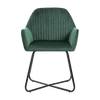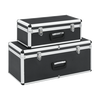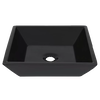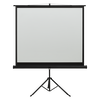Selecting shower enclosures for your bathroom
Investing in the right shower enclosures is a great way to add light and a touch of elegance to your bathroom. They also protect your bathroom floor from splashes, which can present an enormous safety issue and promote the growth of bacteria and germs. However, once the shower enclosure is installed, it becomes the prime focus of your bathroom. So, it’s important to choose one that is worth the attention.
Although the corner is the most common position for shower enclosures, they can be installed virtually anywhere in a bathroom if the plumber permits. Shower enclosures come in a wide range of styles, so choosing the perfect option for your bathroom can be an overwhelming experience. But worry not – we’re here to help you find the right shower enclosure, so read on!
Discover the different types of shower enclosures
The shape and size of your bathroom and shower tray will determine the type of shower enclosure you choose. The shower tray is the foundation of the shower enclosure, so it’s important to ensure it’s installed properly. Here are the main types of shower enclosures you can choose from.
Quadrant shower enclosures
Quadrant shower enclosures are probably the most common type. They are particularly common in new buildings because their curved glass front fits perfectly into tight corners and maximises space usage. There are two types of quadrant shower enclosures: standard quadrant and offset quadrant. Quadrant shower enclosures are also available in various designs and styles to your taste and preference. Most units feature sliding doors, as this is the best way to save space. However, you can find options with hinged outward-opening doors.
D-shaped shower enclosures
These shower enclosures are similar to quadrant enclosures in that they are space-saving models. However, while quadrant enclosures are built to fit in tight corners, D-shaped enclosures are designed for compact bathrooms that may not have a corner. These shower enclosures usually come with sliding doors, although you may find units with the right, left, or twin outward opening doors.
Square shower enclosures
Square shower enclosures are just what their name implies – square in shape. As such, they offer more shower space than other shower enclosures. They are best suited for bathrooms that do not have limited space. Square enclosures are mostly positioned against the wall, but when space allows it, they can be positioned anywhere, even at the centre of the bathroom. Because of the shape of these enclosures, there's more flexibility in terms of the frame and door than can be used.
Rectangular shower enclosures
Like square enclosures, rectangular shower enclosures are best suited for a large bathroom. They also benefit from the versatility of frames and doors that can be fitted. Rectangular shower enclosures are mostly installed along a flat wall, but they can still fit almost anywhere in a bathroom.
Pentagonal shower enclosures
Pentagonal shower enclosures are very similar to quadrant enclosures. Despite being excellent choices for compact bathrooms, pentagon enclosures provide decent space for showering. They also have a flat front door, which gives you a lot of flexibility in terms of the doors that can be fitted. So, aside from sliding doors, you can also go for a bi-fold, pivot, or hinged options. Pentagon shower enclosures also come in a wide range of sizes to suit your bathroom.
Walk-in shower enclosures
These shower enclosures allow you to walk straight in without opening any doors. Most walk-in shower enclosures are made from thick, hardened panels of glass. The panels are usually mounted to the wall and down onto the shower tray. Since these shower enclosures don't come with doors (although they can be fitted if needed), the glass panels are arranged so that water doesn't spill onto the bathroom floor. These shower enclosures' minimalistic design has made them a popular choice among many homeowners.
Which shower door should you choose?
We’ve already mentioned a few types of shower enclosure doors, but it wouldn’t be bad to take a deeper look at the various types to help you choose the best option for your home. Here are the most common types of shower doors for shower enclosures.
Pivot doors
These simple shower doors can be installed to open either inwards or outwards, depending on the design of your bathroom. These shower doors are ideal for people who have more space in their bathrooms because they take up more space when opened. In addition, outward-opening pivot doors can make your floor wet when open, so they're best suited for a wet-room style bathroom with non-slip flooring.
Sliding doors
Unlike pivot doors, sliding doors are great space-saving options, making them a good option for small bathrooms. These shower doors are common in quadrant enclosures, which are often installed in a corner to maximise space. You can use sliding doors in small guest bathrooms or cloakrooms. Another advantage of these shower doors is that they don’t need extra room to open and close. The extra space that would be occupied by an inward or outward pivot door can be used to create a roomier cubicle.
Hinged doors
Another simple design of shower doors, hinged doors are opened and closed like regular doors. They work best in curved and straight shower enclosures and can be configured to open either on the left or right side. Hinged doors come in different styles to suit different décor themes. These shower doors are ideal for bathrooms that are not short of space because they open outwards.
Bi-fold doors
These shower doors are not only functional but also elegant and stylish, thanks to their striking design. Bi-fold doors are the perfect option for people who want to make their shower enclosure the focal point of their bathroom. They are also ideal for people with plenty of space in their bathrooms as they can be purchased in two or three folds.
What material should you choose for your shower enclosure?
The material you choose will determine the look and durability of your shower enclosure. There are a few different materials you can choose from, but the most common option is glass. Below, we look at the most common materials for shower enclosures.
Glass
There are two types of glass: tempered glass and laminated glass. Tempered glass is a form of hardened glass that is made by baking traditional glass under high temperature and cooling it using high-pressure air. This makes it 3 – 5 times more durable than traditional glass. Besides temperature resistance, tempered glass shatters into smaller, less sharp grains, thus reducing damage risk. On the other hand, laminated glass is made by sandwiching a layer of polyvinyl butyral (PVB) in two sheets of glass. The PVB makes the glass hard and difficult to break.
Stainless steel
If you’re looking for an environmentally friendly, easily customizable, and long-lasting shower enclosure, go for one made from stainless steel. All stainless steel shower enclosures feature a highly polished finish with a beautiful shine. They gleam in any environment – whether it’s dark, or bright, traditional or modern. Stainless steel shower enclosures are also fire-resistant. Furthermore, stainless steel is resistant to rust and corrosion. So, you can be sure they will look good for many years.
Acrylic
Shower enclosures made from acrylic are cheaper than those made from glass and metal. They also give your bathroom a smooth, gleaming look and require little maintenance. In addition, this material stays warm, so you don't have to worry about touching a cold surface when entering the shower early in the morning. Acrylic also provides reliable waterproofing as it is a nonporous material. This also means it inhibits the growth of mould and mildew.
What shower enclosure size is best?
Another important point to keep in mind when looking for a shower enclosure is size. You might be tempted to go big when choosing an enclosure, but this will only lead to frustration and disappointment when installing it. The first to choose the right shower enclosure size is to measure the size of your bathroom and the shower tray. The standard dimensions of a shower enclosure are 800mm x 800mm, but many people feel comfortable in an enclosure of 1200mm x 900mm.
If your bathroom has limited space, consider going for shower enclosures that maximise space. You also need to take into account the height of your shower tray. Most shower trays have a low-level design; however, there are incidences where the tray needs to be raised because the waste pipes are above the floor level or insufficient fall of wastewater. In both cases, a tray riser kit will be needed.
Shower enclosure maintenance tips
No one enjoys cleaning shower enclosures, and this is because they tend to accumulate grime and soap scum every day. Unfortunately, it's a job that must be done because leaving it that way will affect the condition of your bathroom and your well-being. Here are a few shower enclosure maintenance tips.
-
Keep them dry
The main enemy of shower enclosures is moisture. Wet floors and damp fixtures are the perfect breeding grounds for bacteria. Use a dry cloth to wipe your shower down after use. Also, keep the shower well-ventilated to prevent moisture buildup.
-
Prevent hard water stains
If you live in an area with hard water, your glass shower enclosure may build up hard water stains, which can damage the glass over time. You can prevent these stains by using a squeegee or microfiber towel to clean the glass after a shower.
-
Protect shower door seals
Shower door seals can be damaged by strong chemicals in your cleaning products. You can protect the seals by cleaning them with warm water and mild soap. Ensure the bottom sweep is particularly clean.
Looking for a top-quality shower enclosure? Here at vidaXL, we have a large collection of shower enclosures in different materials and sizes to your needs. Whether you’re building a new home or simply renovating your bathroom, you will find the best shower enclosure from our collection.





























































